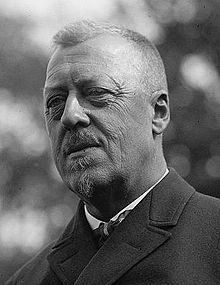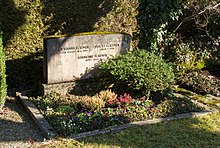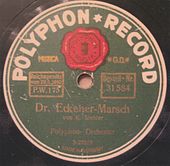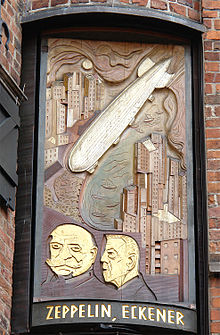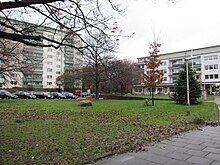Hugo Eckener
Hugo Eckener (born August 10, 1868 in Flensburg , † August 14, 1954 in Friedrichshafen ) was the successor to Count Ferdinand von Zeppelin . Under his leadership, the airships LZ 126 / ZR-3 Los Angeles , LZ 127 Graf Zeppelin and LZ 129 Hindenburg were built .
Life
Hugo Eckener was the son of the cigar manufacturer Johann Christoph Eckener (1824–1880) and his wife, the shoemaker's daughter Anna Maria Elisabeth Eckener (née Lange, 1832–1893) from Flensburg. He attended the St. Marien boys school and later the old grammar school . After graduating from high school , he studied psychology, philosophy, history and economics in Munich, Berlin and Leipzig and received his doctorate in 1892 under Wilhelm Wundt with the work investigations on the fluctuations in the perception of minimal sensory stimuli .
At a young age he worked as a freelance writer and employee of the national liberal Flensburger Nachrichten . He was married to the daughter of the Flensburg printer's owner LPH Maaß, Johanna (1871–1956). His younger brother was the painter and graphic artist Alexander Eckener .
As a correspondent for the Frankfurter Zeitung, for which he also worked, he is said to have come into direct contact with Count Zeppelin through one of his newspaper reports on the Zeppelin airship in 1908, which later resulted in a long-term, successful collaboration. His criticism of the Zeppelin airships was initially negative. However, the count succeeded in convincing Eckener of the correctness of his line of thought.
At the end of the 1890s, Eckener moved from Flensburg to Friedrichshafen. Eckener was the route manager and authorized signatory of the Deutsche Luftschiffahrts-Aktiengesellschaft (DELAG) founded in 1909 . From 1912 he took over their management. Even before the First World War, he successfully carried out more than 1,000 trips in airships.
In 1910, Eckener was on board the Zeppelin LZ 7 , which crashed nine days after its maiden voyage on June 28 after an engine failure in a storm on Limberg near Iburg in the Teutoburg Forest . Nobody was harmed in the accident.
During the First World War , Eckener trained many naval airmen in Nordholz and other places, including Hans Flemming .
When the end of German airship construction seemed to have come after the end of the First World War, Eckener succeeded in getting the United States interested in the airship. A contract was signed with the obligation to build an airship for the USA. To prove that the ship was fit to sail, this delivery contract was subject to the condition that the contract could only be regarded as fulfilled after the Zeppelin had been transferred across the Atlantic.
On October 12, 1924, Eckener took off from Friedrichshafen on Lake Constance in the Zeppelin LZ 126 to cross the Atlantic. The airship, later renamed the ZR-3 USS Los Angeles , was part of the German reparations payments to the United States as a result of the First World War. With the landing in Lakehurst on October 15, 1924, Eckener made one of the first non-stop flights across the Atlantic :
This trip became a worldwide success and it laid the foundation for the revival of the airship concept. Only a British aircraft and the British R34 rigid airship had previously been able to do this. The city of Flensburg then made him an honorary citizen in the same year .
After the successful delivery trip with the LZ 126, Eckener collected money for the construction of the LZ 127 with lectures and pictures of the trip . The world trip with the Graf Zeppelin in 1929 earned him the nickname “ Magellan of the Skies” in the press . His son Knut also worked as a crew member on the Zeppelins LZ 127 and LZ 129 and was therefore sometimes directly subordinate to Eckener.
Eckener was multiple honorary doctorates, honorary senator and honorary citizen. Between the world wars, he was one of the most highly decorated Germans and was a very well-known man internationally, and not just in specialist circles for airship travel. Eckener also published various books and writings.
Eckener can claim the fame of having set up the first regular airship service across the oceans.
In the 1920s there were several encounters with the polar explorer Roald Amundsen to discuss a joint trip to the Arctic with the zeppelin. After the death of Fridtjof Nansen in 1930, Eckener succeeded him as President of the Aeroarctic Society . In 1931 he led the Arctic voyage of the LZ 127 Graf Zeppelin . To get more publicity, he had agreed with Hubert Wilkins and his sponsor Lincoln Ellsworth that the airship should meet at the North Pole with their submarine Nautilus . When the departure of the Nautilus was delayed, Eckener changed his plans and instead met on July 27, 1931 in the Silent Bay ( Russian Бухта Тихая , Buchta Tichaja ) on Hooker Island ( Franz Joseph Land ) with the Soviet icebreaker Malygin .
In the course of the investigation into the accident of the British airship R101 in 1930, Eckener was called in as an expert.
In 1932, Eckener was even traded as a candidate for the presidential election. Eckener withdrew the candidacy, however, when Hindenburg ran for re-election.
Then he continued to build and operate civilian airships. Between 1931 and 1937 a regular transatlantic line service between Frankfurt, the USA and Brazil with the two Zeppelins LZ 127 and LZ 129 of the German Zeppelin Reederei founded by Eckener was set up. In May 1937 there was a momentous explosion of the Zeppelin LZ 129 Hindenburg in Lakehurst, USA, in which 36 people died.
Since he did not succeed in obtaining the incombustible gas helium from the USA, with which he could have replaced the highly flammable hydrogen, passenger journeys with the luxurious zeppelins were stopped. Eckener was now considered to be partly responsible for the disaster. In 1939, before the start of the Second World War, he withdrew from the public and took over the management of a mechanical engineering company. According to his information in the questionnaire on denazification , he was completely apolitical and belonged neither to the NSDAP nor to any subsidiary organization and had not participated in any political elections since 1932. He did not attach any importance to the fact that he was appointed military economic leader in 1939 .
In 1945 he was a co-founder of the Südkurier in Konstanz .
In 1947, Eckener stayed in the United States for seven months and worked as a consultant for Goodyear Aircraft Corporation at the invitation of Director Paul W. Litchfield (1875-1959) . In the mid-1940s the decision was made to build a new type of large airship that could also have been used to transport freight . However, due to a lack of government funding, the project did not materialize - one possible reason why in the 1950s, Eckener was negative about the ideas that were emerging in Germany around the so-called Frankfurter Kreis to revive German airship travel .
Hugo Eckener died four days after his 86th birthday on August 14, 1954 and was buried in the Friedrichshafen main cemetery. His wife Johanna, with whom he was married for 59 years, died in January 1956.
Honors, awards
- Iron Cross 1st Class (1917)
- Honorary citizen of New York (1924) after crossing the Atlantic and landing in Lakehurst near New York on October 15 on the occasion of the handover of the Zeppelin ZR III as a reparation payment, at the same time a peace mission and rapprochement between Germany and the USA
- Member of the Leopoldina Science Academy and the Leopoldina Cothenius Medal (1925)
- Honorary doctorate in technical sciences from the Graz University of Technology (1925)
- Honorary Senator of the University of Tübingen (1925)
- Honorary membership in the Association for the History of Lake Constance and its Surroundings (1938)
- Great Cross of Merit of the Federal Republic of Germany (1952)
- In honor of the Zeppelin designer Hugo Eckener, the composer Theodor Ludwig Karl Krieghoff created the Dr. Eckener March for the salon orchestra / piano / string music / brass music has been published.
- In honor of Eckener, the Friedrichshafen composer Kaspar Siehler also received a Dr. Eckener March has been published.
The following are named after him:
- the Eckener School in Flensburg
- the Eckener Haus (his birthplace) in Flensburg
- the corner street in Flensburg
- the Eckener high school in Berlin-Mariendorf
- the Hugo Eckener School in Friedrichshafen (commercial school)
- the Eckenerstraße in Friedrichshafen
- the Eckenerstraße in Bautzen
- the Eckenerstraße in Bayreuth
- the Eckenerstraße in Braunschweig , in the vicinity of the Braunschweig-Wolfsburg airport
- the Eckenerstraße in Bremen - Sebaldsbrück
- the Eckenerstraße in Castrop-Rauxel
- the Eckenerstrasse in Düsseldorf
- the Eckenerstraße in Eschborn
- the corner street in Esslingen
- the Eckenerstraße in Gaggenau
- the Eckenerstraße in Göppingen - Faurndau
- the Eckenerweg in Göppingen
- the Eckenerstrasse in Hamburg-Tonndorf
- the Eckenerstraße in Hamm (until 1975: Zeppelinstraße)
- the Eckenerstraße in Hanover
- the Eckenerstraße in Haibach in the Aschaffenburg district
- the corner street in Heidelberg
- the Eckenerstraße in Heilbronn
- the Eckenerstraße in Hildesheim
- the corner street in Karlsruhe
- the Eckenerstraße in Königsbrunn
- the Eckenerstraße in Ingolstadt
- the Eckenerstrasse in Landau in the Palatinate
- the Eckenerstraße in Löbau
- the corner street in Lübeck
- the corner street in Ludwigsburg
- the Eckenerstraße in Markgröningen
- the Eckenerstraße in Meckenbeuren
- the corner street in Mering
- the Eckenerstrasse in Münster
- the Eckenerstraße in Neu-Ulm
- the Eckenerstraße in Ostfildern
- the Eckenerstrasse in Reutlingen
- the Eckenerstrasse in Rheine
- the corner street in Sankt Augustin ( Hangelar )
- the corner street in Tamm
- the Eckenerstraße in Tübingen
- the Eckenerstraße in Ulm
- the Eckenerstraße in Weimar
- the Eckenerstraße in Villingen-Schwenningen
- Hugo-Eckener-Allee at Berlin Brandenburg Airport BER
- the Hugo-Eckener-Ring at Frankfurt Airport
- the Hugo-Eckener-Ring in Neuruppin , on the former airfield site
- Hugo-Eckener-Strasse in Augsburg , on the old airfield, today the university district
- the Hugo-Eckener-Strasse in Filderstadt
- the Hugo-Eckener-Strasse in Cologne
- Hugo-Eckener-Strasse in Leinfelden-Echterdingen
- Hugo-Eckener-Strasse in Lahr / Black Forest
- Hugo-Eckener-Strasse in Mainz-Gonsenheim
- Hugo-Eckener Strasse in Mönchengladbach
- Hugo-Eckener-Strasse in Oldenburg
- the Hugo-Eckener-Strasse in Stuttgart
- the Dr.-Eckener-Straße in Ahlhorn (Großenkneten)
- the Dr.-Eckener-Strasse in Rendsburg
- the Dr.-Eckener-Strasse in Borken (Hesse)
- the Dr.-Eckener-Strasse in Gera
- the Dr.-Eckener-Straße in Osnabrück
- the Dr.-Eckener-Strasse in Saarbrücken
- the Dr.-Eckener-Strasse in Zweibrücken
- the Dr.-Hugo-Eckener-Weg in Erfurt
- the Dr.-Eckener-Gasse in Wiener Neustadt
- the Dr.-Eckener-Strasse in Graz
- the Dr.-Eckener-Platz in Neu-Isenburg , in the Zeppelinheim district
- the Eckenerplatz and the Eckenerweg in Kiel-Holtenau
- the Eckenerplatz, a soccer field in Flensburg
- the Hugo Eckener Laboratory at the Zeppelin University in Friedrichshafen
- the Hugo Eckener , an auxiliary ship of the People's Navy
- the Hugo Eckener , a motor lifeboat on Lake Constance, operated by the DLRG Friedrichshafen
- the Eckener Point , a headland on the west coast of Graham Lands, Antarctica
Publications (selection)
- Investigations into the fluctuations in the perception of minimal sensory stimuli. In: Philosophical Studies. Volume 8, 1893, pp. 343-387.
-
In the zeppelin over countries and seas. Christian Wolff, Flensburg 1949.
- In the zeppelin over countries and seas - experiences and memories. Edited and updated version of the original edition from 1949. Morisel, Munich 2012, ISBN 978-3-943915-01-3 .
- Count Zeppelin. Cotta, Stuttgart 1938. New edition: Phaidon-Verlag, Essen 1996, ISBN 3-88851-171-2 .
literature
- Walther Reimer: Eckener, Hugo. In: New German Biography (NDB). Volume 4, Duncker & Humblot, Berlin 1959, ISBN 3-428-00185-0 , p. 288 ( digitized version ).
- Rolf Italiaander: A German named Eckener. Verlag Friedr. Stadler, Konstanz 1981, ISBN 3-7977-0054-7 .
- Rolf Italiaander : Hugo Eckener - the world show of an airship. Husum-Verlag, Husum 1980, ISBN 3-88042-110-2 .
- Henry Cord Meyer: Airshipmen, businessmen, and politics, 1890-1940. Smithsonian Institution Press, Washington / London 1991, ISBN 1-56098-031-1 .
- Obituary Hugo Eckener, in: Writings of the Association for the History of Lake Constance and its Surroundings , 73rd year 1955, pp. 9-10 ( digitized version )
Web links
- Literature by and about Hugo Eckener in the catalog of the German National Library
- Works by and about Hugo Eckener in the German Digital Library
- Newspaper article about Hugo Eckener in the press kit of the 20th century of the ZBW - Leibniz Information Center for Economics .
- The Austrian Zeppelin ride. Dr. Hugo Eckener leads the ship. In: Neue Freie Presse , Morgenblatt, No. 23998/1931, July 7, 1931, p. 13. (Online at ANNO ). .
- Hugo Eckener. Tabular curriculum vitae in the LeMO ( DHM and HdG )
- Report on the LZ 126 (ZR-3) crossing the Atlantic in October 1924, a speech (September 7, 1925) by Hugo Eckener.
- Denazification files Hugo Eckener as digital reproduction ( files 1 and 2 ) in the online offer of the Sigmaringen State Archives
Individual evidence
- ↑ Herrmann Degener: Degeners Who is it? , Berlin, Verlag Herrmann Degener, 1935, p. 337.
- ↑ Erich Rackwitz: Travel and Adventure in the Zeppelin . New Life Publishing House, Berlin 1955, p. 202
- ↑ Bleibler, J. (2002): The fifties and sixties - large airship projects in Germany and the USA, in: Meighörner, W. (Ed.): Airships that were never built, Friedrichshafen, pp. 151–175.
- ↑ a b Dr. Eckener March. From: Kaspar Siehler on YouTube , accessed on February 7, 2017.
- ↑ a b Kaspar Siehler. In: Deutsche Digitale Bibliothek / Landesarchiv Baden-Württemberg, Department State Archive Sigmaringen, Wü 13 T 2 No. 2607/159, accessed on February 6, 2017.
- ↑ Denazification files on landesarchiv-bw.de
- ↑ Flensburger Tageblatt of June 11, 2015, p. 6
- ↑ The Graz honorary doctorate for Lieutenant Commander Eckener. In: Badener Zeitung , May 9, 1925, p. 5 middle. (Online at ANNO ).
- ^ Mathias Kotowski: The public university: Event culture of the Eberhard-Karls-Universität Tübingen in the Weimar Republic. Franz Steiner Verlag, 1999, page 147
- ↑ Harald Derschka : The association for the history of Lake Constance and its surroundings. A look back at one hundred and fifty years of club history 1868–2018. In: Writings of the Association for the History of Lake Constance and its Surroundings , 136, 2018, pp. 1–303, here: p. 229.
- ↑ Dr. Eckener March. From: Th. Krieghoff on YouTube , accessed February 7, 2017.
- ↑ Th. Krieghoff. From the Smithsonian Institution catalog, accessed August 20, 2015.
| personal data | |
|---|---|
| SURNAME | Eckener, Hugo |
| BRIEF DESCRIPTION | Head of the Zeppelin factory in Friedrichshafen and the first to cross the Atlantic in a zeppelin |
| DATE OF BIRTH | August 10, 1868 |
| PLACE OF BIRTH | Flensburg |
| DATE OF DEATH | August 14, 1954 |
| Place of death | Friedrichshafen |
